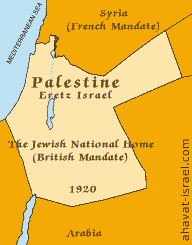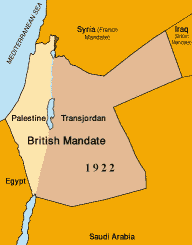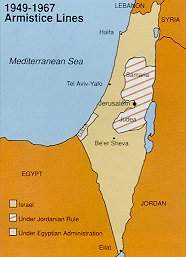Nevertheless, in July 1922, the British divided Palestine into two administrative districts. Note the black line on the map. Jews would be permitted only west of the black line. To the east, in what became known as "Transjordan", the British installed a Hashemite ruler named Abdullah, who had been expelled from the Arabian peninsula.(1) By making this division, the British reduced the area available for the Jewish National Home to only 22% of the entire area of Palestine.
1. For the creation of Transjordan, see Sachar, op. cit., pp. 402-406
On the map making process (French officers in the 1930s realized their maps mistakenly put Shaba on the Syrian side of the border... for more )
The Arab-Israeli Conflict
The following article was first published on March 18, 1988. Every word is still relevant today. Written in response to the anti-Israel environment that plagued North American campuses and terrorized Jewish students there during the Intifada Arab riots starting in December 1987. This article was published in over 200 North American universities, including Harvard, Stanford and Yale. Permission is granted to reprint this article in any publication in accordance with the copyright.
The normal reaction to televised images of soldiers manhandling demonstrators is to regard the soldiers as brutal and the rioters as heroic. The trouble with much of the thinking about the Arab-Israeli conflict today is that it relies on television as a source of information. Simplistic and superficial, the coverage views the present situation out of the context of history.
Prior to 1918, Arabia was ruled by the Turks in the Ottoman Empire. The Arabs were a disenfranchised people living side by side with many minorities including Armenians, Kurds, Jews, Circassians and Druzes. Jews had been living in the Middle East long before the Romans destroyed their Second Temple in 70 AD, and at all times there was a Jewish community living in what remained for them the Land of Israel.
During WWI influential Arab leaders were promised independence by the Allies if they rose up against their Turkish overlords. The Allies carried out their promises to the Arabs, and the Ottoman Empire was eventually carved up into separate sovereign Arab states, The British also issued the Balfour Declaration in 1917, which promised the Jews a national home in Palestine.
 World War I treaties gave Britain the area known as Palestine on condition that they hold it in trust - as a Mandate - for the Jewish homeland. But instead of implementing the Balfour Declaration as promised, Britain partitioned Palestine in 1922 and created Transjordan, which was later to become the independent State of Jordan. Thus, 76 per cent of the Jewish National Home in Palestine was allocated as an autonomous area to the Arabs of Palestine. The British government then committed itself to a policy that severely limited Jewish immigration to Palestine. Even as the Jews tried frantically to escape the holocaust in Europe, the British kept the gates of Palestine closed. The Jews soon found that they had to fight quota certificate by certificate, for the right to come and populate their homeland.
 On February 1947, Britain decided to refer the entire problem to the United Nations. The General Assembly appointed a special commission on Palestine which proposed the partition of the remaining area of Palestine into Arab and Jewish states with an international trusteeship for Jerusalem. The United Nations General Assembly accepted this, and it was finally voted as the Partition Resolution of 29 November 1947. While the Jewish population welcomed it, the Arab states rejected it and vowed to destroy any emerging Jewish state.
The State of Israel was born on 14 May 1948, as the British finally left the country. The Arabs and other minorities in Israel became Israeli citizens, and were given the same status in law as Jewish Israelis. Because of the Arab rejection, the Palestinian Arab state was aborted. Six Arab armies (Egypt, Syria, Transjordan, Saudi Arabia, Lebanon and Iraq) immediately invaded Israel, but failed in their attempt to destroy the nascent state.
 Between February and July 1949, Israel signed armistice agreements with Egypt, Lebanon, Jordan and Syria. Thus the State of Israel was established within borders constituted by the lines agreed upon in these agreements. The Gaza Strip remained in the hands of the Egyptians, while the West Bank, and most of Jerusalem, remained under Jordanian occupation.
Two large refugee problems were created as a result of the Arab-Israeli conflict each encompassing approximately 800,000 persons. A Palestinian Arab refugee problem and a Jewish refugee problem, the latter created when the Jewish populations in Arab countries were exiled from their countries.
It is sobering to reflect that the Arab oil revenue generated in one day even in 1949, would have sufficed to solve the entire Arab refugee problem. But this was not to be.
|
The Jewish people and the State of Israel solved the Jewish refugee problem rapidly and reestablished the Jewish refugees, primarily in Israel. But the Arab governments chose to perpetuate the Arab refugee problem, to use the Arab refugees as political pawns over the years, and to allow generations to be born and to grow up in miserable refugee camps in the Middle East supported by international charity. It is sobering to reflect that the Arab oil revenue generated in one day even in 1949, would have sufficed to solve the entire Arab refugee problem. But this was not to be.
In 1949, the representatives of the Palestinian Arab refugees attempted to bring their case-before the Palestinian Conciliation Commission, meeting in Lausanne, and sought a compromise with Israel, but their action was disowned by the Arab governments.
On numerous occasions, Ben-Gurion offered to meet the Arab leadership (as indeed did all future Israeli prime ministers) in order to work out a compromise, but until President Sadat's historic trip to Jerusalem in November 1977 no Arab leader was prepared to take such a step. The core of the problem became, and remained, the refusal of the Arab states to recognize the right of the Jewish State to exist.
Jordan was in control of the West Bank and Egypt was in control of Gaza. Had they so desired, they could have established a Palestinian state in these areas.
|
Within months of the signing of the 1949 armistice agreements, border incursions, raids, economic warfare, and other violations against Israel became the order of the day. In 1964, an Arab Summit Conference in Cairo attended by the heads of state decided as a matter of policy to set up the Palestine Liberation Organization. In 1965, the PLO was formally established at a Conference in Jerusalem, and the Palestine Covenant which became the political basis for the movement, was enunciated. At the time, Jordan was in control of the West Bank and Egypt was in control of Gaza had they so desired, they could have established a Palestinian state in these areas. However, this was not to their purpose, nor was it to the purpose of the PLO, which was unwilling to accept any compromise in regard to those sections of the Palestine Covenant calling for the destruction of the State of Israel.
In May 1967 the Arab states, led by Egypt, again plunged the Middle East into crisis. In a speech on 26 May, President Nasser of Egypt told the Arab Trade Union Congress that this time it was their intention to destroy Israel. In coordination with Egypt, Syria prepared to attack Israel from the Northeast Jordan joined the alliance on may 30, and Iraq on June 4. Contingents were dispatched from Algeria, Morroco, Saudi Arabia and Kuwait to join in the assault. The world looked on at what was believed by many to be the impending destruction of Israel. But no international action was taken. Every effort was made by the Soviet and Arab delegates to the United Nations to pre-empt any effort that might be made by the West to intervene and obstruct the Arab plans. Israel, it seemed, was on her own.
On the morning of June 5, 1967, the battle began and, after six days of intensive fighting, the Israelis emerged victorious. Following the Six-Day War, Israel hoped that the Arab states would finally recognize the reality of its existence and enter into peace negotiations. Israel signaled to the Arab states its willingness to relinquish virtually all of the territories captured during the battle in exchange for a genuine peace. But these hopes were dashed when the Arab Summit Conference at Khartoum on September 1967 passed the �three noes� resolution � �no peace with Israel, no negotiations with Israel, no recognition of Israel�"
Israel signaled to the Arab states its willingness to relinquish virtually all of the territories captured during the battle, in 1967, in exchange for a genuine peace.
|
In 1970, after failing in its attempt to take control of Jordan, the PLO moved its base of operations from Jordan to Lebanon. In 1975 civil war broke out in Lebanon, which bordered Israel, to the north. The chaotic situation in war torn Lebanon enabled the PLO to use Lebanon territory as a jumping-off ground for terrorist attacks against the Israeli population. Since the early 1950's, Israel has been subjected at various periods to terrorist attacks from across the borders, and has invariably reacted in reprisal raids. In 1968, the Palestine Liberation Organization launched its first attack against Israel overseas, by hijacking an El Al airliner flying from Rome to Tel-Aviv and diverting it to Algeria. .
The policy adopted by Israel from the outset rejected any form of compromise with terrorism, and was designed to stamp it out wherever it might appear. At a conference on international terrorism in 1976, Shimon Peres, who is now (1988) the head of the Israeli Labor Party, enunciated Israeli policy. He emphasized that there should never be surrender to terrorism, and terrorism should be fought in both the operational field and the psychological field.
Peres said, �The tendency of terrorist groups to bedeck themselves with titles such as the 'Red Army' or the 'Liberation Organization' should not beguile us or our often bewitched media... Terrorist groups should be described in their true colors - groups which are impatient with democracy, which are undisciplined, corrupt in their attitude to life, and unable to free themselves from the domination of murder and hatred.� He pointed out that terror has become international and must be fought internationally. The terrorists consider most free nations and peoples as their enemies; countermeasures must therefore be internationally coordinated.
�Peace for us means the destruction of Israel.�
|
During an interview in 1980, Yasser Arafat, the Chairman of the PLO, explained his organization's point of view. As he put it, �Peace for us means the destruction of Israel.� The inherent inflexibility of the PLO precludes any meaningful role on the part of this organization in achieving a peaceful solution to the Israeli-Arab conflict. Developments between Israel and the Arab world will be decided by Israel and sovereign Arab states such as Egypt, Syria or Jordan. The problem of the Palestinian refugees will be solved as soon as the 40 year old war comes to a peaceful conclusion.
Arabs and Jews, however, are but two of the elements at work in the political arena of the Middle East. Gradually, the world superpower rivalry spilled over into the Middle East and came to military expression on the battlefields of the area. Parallel to a policy of maintaining Israel's defensive capability in the face of the growth of Soviet military supplies to Arab countries such as Syria, the US efforts are directed to a political solution by means of negotiations on the basis of UN Security Council Resolution 242, which was adopted on 22 November 1967. This resolution called for �withdrawal of Israeli armed forces from territories occupied in the recent conflict" as well as the right of "every State in the area� to live in peace within secure and recognized boundaries free from threats or acts of force.� United States direct involvement led to the Camp David peace accords signed on September 1978, and to the signing of the Israel-Egypt Peace Treaty on March 1979.
The Arab countries are convulsed today by the impact of the twentieth century on medieval societies that have achieved untold wealth almost overnight. The Middle East is the scene of strife, revolution and unrest. Islamic fundamentalism dominates and seeks to subvert and overthrow many regimes. Added to this unrest is the military technology acquired by oil wealth. The outlook is both sobering and alarming.
The Arab-Israeli conflict must be viewed against a background that encompasses a political, historical and human point of view.
"The fact that there are these refugees is the direct consequence of the act of the Arab states."
|
Emile Ghoury, Secretary of the Palestine Arab Higher Committee, said on September 6, 1948, in an interview with the Beirut Telegraph: "The fact that there are these refugees is the direct consequence of the act of the Arab states in opposing partition and the Jewish state. The Arab states agreed upon this policy unanimously, and they must share in the solution of the problem."
The dilemma is acute, and it is small comfort to those watching the recent developments to know that it is mainly the result of the Arab states refusal to recognize the right of the Jewish State to exist. But, unless yesterday is understood, the anguish of today is distorted and the peace is put off indefinitely. Peace, which in the end must mean recognition of Israeli security and recognition of the rights of the Palestinian refugees, is possible. The only way to move on is to face the reality and lessons of the past.
|  |


How can I help fight Delegitimization?
ReplyDeleteIAN’s (Israel Action Network) Community Mobilization Manual, outlines 10 steps for combating Delegitimization in your communities:
• TIP 1: Understand the Challenge
• TIP 2: Is this Criticism or Delegitimization?
• TIP 3: Know your Facts; Do the Research
• TIP 4: Identify your Audience: Supporters; Opponents; Target Communities of Concerned Individuals and Organizations
• TIP 5: Take an Inventory of your Assets: People; Skills; Program; Missions; Cultural Events; Monetary Resources
• TIP 6: Map Out your Strategies
• TIP 7: Clean your Message Slate
• TIP 8: Engage
• TIP 9: Stay Connected and Networked
• TIP 10: Evaluate; Applaud Successes; Reward Advocates; Invest in What Works